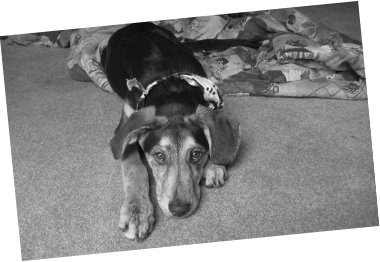So question # 1 : What Causes a dog to bite?
This is a very broad question and there are many possible answers but a few common reasons are as follows: a dog may be trying to protect something such as a toy or food, or their owner or owner's property. Another very common reason for biting is out of fear of a perceived threat. Overexcitment during play or chasing can also lead a dog to bite. Finally injury or pain can predispose an otherwise docile dog to becoming aggressive.
Question #2: What are some signs of stress in dogs?
These are great things to become familiar with. If you see a dog showing these signs it's a good idea to give them space and leave them alone. One of the keys to dog bite prevention in many situations is to let a dog have space and let them choose if they want to interact with you or not. Signs of stress include yawning, rapid panting, pinning the ears down or to the side, licking the lips and showing the white parts of the eyes. If you approach a dog and it turns its head away from you, holds its tail very low or has a very slow wag the dog is trying to tell you he doesn't want you to come closer.
Right before a bite a dog may become suddenly stiff, hold its head low and possibly curl its lip. A good rule of thumb is if a dog is wiggly and relaxed it is unlikely to bite but a dog that is stiff like a statue can be dangerous.
 |
| Photo provided by http://www.dfdk9.com/ |
Question #3 What role does proper obedience training play in reducing dog biting events?
Proper obedience training and socialization of young dogs and puppies is crucial to helping prevent dog bites. Firstly puppies should not be removed from their litter too young as they learn proper bite inhibition (not to bite too hard) from their mothers and litter mates. Puppies should not go to new homes before the age of 8 weeks and to be honest staying in the litter even longer is beneficial to social skills. Once you have your new dog its important to expose it to new people, and other dogs that you know are friendly and that are up to date on vaccines. Ask your vet before introducing a young puppy to new dogs to make sure you won't put your puppy at extra risk of infections. Obedience training is recommened for all dogs as it will help your puppy get used to new people and other dogs in a controlled setting. It will also teach a young dog how to communicate with their owner, builds trust between dog and owner and can help fearful dogs to become more confident and comfortable.
Question #4 Should young children ever be left alone with a dog?
This one seems like a no-brainer but I can't emphasize enough that young children should NEVER be left alone with a dog. What I think is especially important to know here is that it's not just umfamiliar dogs or dogs outside the family that we need to be careful with. In fact 3/4 of dog bites are inflicted by known or family dogs and most victims are children. The majority of bite incidents also occur on the victims own property. This means most dog bites actually occur with a known family pet. I also want to mention that just being in the same room with the child and dog doesn't cut it. If your child and the dog are out of your reach then your child is still at risk for a bite.
Question #5 What should you do if an unfamiliar dog approaches and is off leash?
There is a really excellent education program aimed at children called "Be A Tree" that teaches what to do in this scenario. Step 1 is fold your branches meaning bring your arms to your side and clasp your hands in the center. Step 2 Watch your roots grow. Look down at your feet and don't make eye contact with the dog. Step 3 Count in your head until help arrives or the dog goes away. Pretty simple and easy to remember. If you are on the ground when a dog approaches curling up into a ball or the fetal position is an alternative method to protect yourself. I think all children should be taught "Be A Tree" as early as possible.
 |
| Photo from www.doggonesafe.com |
Final Question: what are your final words of advice for dogs owners and parents?
For dog owners: keep your dogs on leash when out in public and keep your dogs up to date on their rabies vaccines. Rabies is a real public health concern and we do have it in Manitoba. For parents: teach children as early as possible to learn the signs of a stressed dog compared to a relaxed dog. Teach children not to hug or ride dogs and that it is best not to pet a dog directly on top of their heads. These precautions alone should help reduce your risk of being involved in a bite incident. Children and dogs can make great companions and friends but only if the right steps are taken to protect both the child and the dog.
 |
| www.doggonesafe.com |
Thanks for reading!
Dr Ingrid

















No comments:
Post a Comment